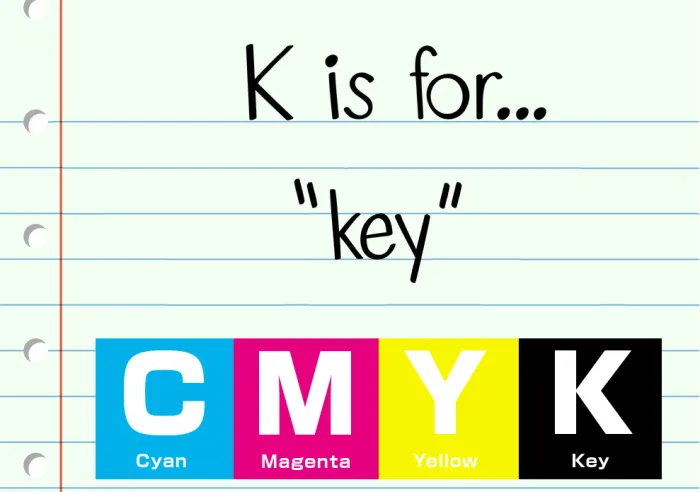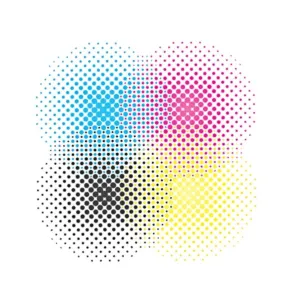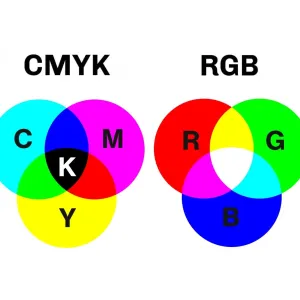Why is the color Black designated by the letter "K" in CMYK?

estimated reading time: 5 minutes
Printing companies all over the world use CMYK printing to
produce full-color output. CMYK is a printing process that uses only four ink colors:
Cyan, Magenta, Yellow, and Black. When combined in varying concentrations (from
0% to 100 %) these four ink colors can create over 16,000 colors.
What does the "K" in CMYK stand for?
It makes perfect sense that "CMY" is used to designate the Cyan, Magenta, and Yellow ink colors, but what does the "K" in CMYK stand for? Well, there are two main theories surrounding the use of the letter "K" in CMYK...
We know Black is one of the four ink colors used in the 4-color CMYK printing process, so one theory is that using the first letter of "B" would have caused confusion with the color Blue. If we give merit to this explanation, then it is probably also safe to conclude that the last letter of the word Black was chosen to represent the color instead of the first letter. Hence, a K was used instead of a B.
However, if you think about it, choosing a "K" over a "B" to avoid confusing Black with Blue doesn't actually add any clarity. It just shifts the confusion from a "B" to a "K." After all, people have been debating what the "K" stands for ever since the term "CMYK" was first introduced. So if the "K" was chosen to clearly indicate the fourth ink color, then the "K" was a swing and a miss (baseball pun intended).
Even though the Black and Blue theory has its share of supporters, there seems to be even more support for a second explanation...that the letter "K" stands for "Key." In fact, the majority of commercial printers ascribe to this second explanation.
The use of the word "Key", in this context, refers to something that is vitally important, like a Keystone.
So in the case of CMYK printing, something that is vitally important to achieve an optimal production run would be a Key
color or a Key printing plate.
So it is completely reasonable that, over time, the term "Key color" or "Key plate" got
abbreviated to simply "K." And this "K" became universally recognized as
representing Black in the CMYK color model.
But why is Black the "Key" color for CMYK Printing?
When printing on a white or light-colored paper stock (which
describes 99% of print jobs) a darker ink color will provide the most contrast.
Since black is the darkest color, its deep tone adds the highest level of definition
and detail to a printed image. Hence, it is the "Key" color for CMYK
printing.
When CMYK printing was first introduced, offset printing was
the prevailing method of printing (and still is to this day). Offset printing
is a wet-on-wet technique that lays down the four CMYK ink colors in
succession. The order of the ink applications vary by printing company, with black being either the last CMYK ink color
to be laid down or the first. However, the cyan, magenta, and yellow
inks are almost always laid down in the order of CMY.
The four CMYK ink colors are applied in the form of
tiny dots that overlap each other on the paper. Because each ink color is applied to the paper separately, an offset printing press must undergo
a calibration process at the beginning of the production run. This ensures all four
colors are in register. Because the Key color (Black) provides the most definition
and detail, it is the color to which the three colors of CMY are registered. This
is another reason why black ink is considered the Key color for CMYK printing.
On print projects that do not use the CMYK process, any ink color
could technically be designated as the Key color. For example, a project could
print in multiple Pantone colors without the use of black ink. In this case,
the darkest color would likely be used as the key color to align the other
colors during the upfront calibration procedure.

Why does CMYK even need Black ink? Won't combining the other three CMY colors create Black?
Though combining Cyan at 100%, Magenta at 100%, and Yellow at 100%
will produce a dark color, it isn't a true black. It is more of a dark
brownish gray. Thus, black ink is a necessary component of CMYK printing
because it prints as a truer black.
In addition to providing a darker shade of black, using 100% black offers other advantages over the combination of the three CMY
inks…
> Using the single black ink color is much cheaper than using the three cyan, magenta, and yellow inks in combination.
> Layering dense levels of cyan, magenta, and yellow will build up too much ink on the paper, potentially saturating the sheet. The heavy coverage also slows down the drying time and increases the risk of ink being transferred onto adjacent sheets. Using black ink as a standalone color avoids these problems.
> When printing text, using the three CMY colors to approximate the color black would require them to be kept in extremely tight register in order to avoid blurriness and a loss of resolution. This is hard to accomplish on the fine details of text. Conversely, using black ink by itself will easily maintain the sharpness needed. This is because the black is only applied as a single ink color and doesn't need to be brought into register with any other ink colors when printing text.
In conclusion, we hope you now have a better understanding
of what the "K" in CMYK stands for and how this terminology evolved from the technical aspects of offset print production. We also hope you recognize the importance of using black ink as the Key color in the CMYK printing process.
If you are looking for CMYK printing, Color Vision is your go-to source!
If you have a full-color printing project you would like to
discuss, give Color Vision a call at 800-543-6299. Or, if you
know your project's specs and would like a written quote, simply fill out our
Quote Request form and we will send you a quote via email.
As a full-service provider, Color Vision has both offset and
digital printing capabilities. So, whether you need a short, medium, or long
production run, we have the expertise to make your printing project a success.
As always, we look forward to assisting you!
Related Article: What is Rich Black?
Related Articles

Commercial Printing: What does “Halftone” mean?
Read This Article

The Difference between CMYK and RGB Color Models
Read This Article

Printing Ink: What does “Heavy Coverage” mean?
Read This Article

Which Process is Better? Digital Printing vs Offset Printing
Read This Article